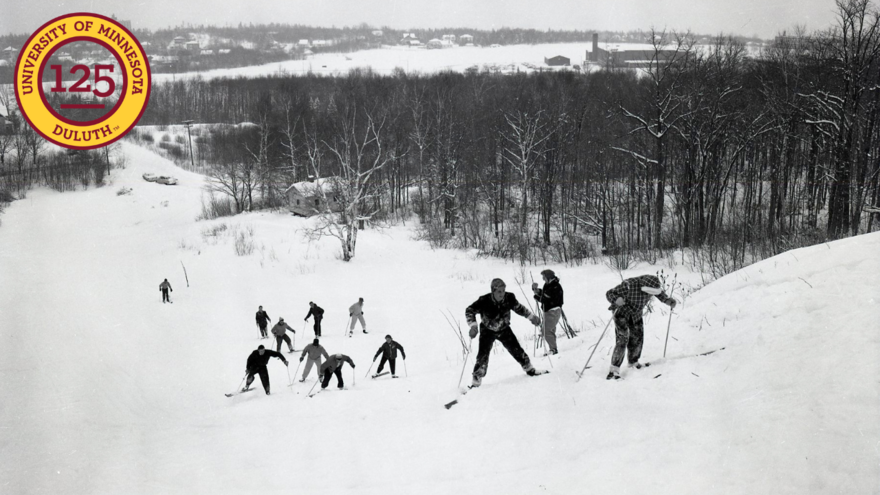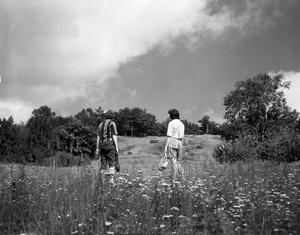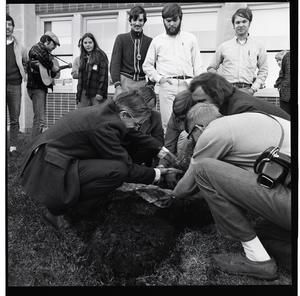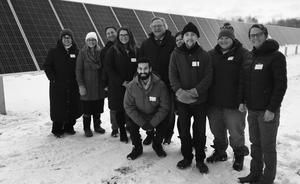
10-22-2020
We’re celebrating UMD's quasquicentennial anniversary by going back in time to remember some of our significant sustainable achievements.
Four name changes and one move later, the University of Minnesota Duluth continues to evolve and grow as time passes. Our campus looks very different today from the women’s teaching school it began as, but our passion for education and engagement has remained. Help us celebrate 125 years of learning by remembering some of our biggest sustainability achievements:

- April 2, 1895: MN Gov. David M. Clough approves what will later become UMD; the State Normal School at Duluth.
- 1918: The Spanish Flu Epidemic forces the State Normal School to temporarily close.
- 1921: The State Normal School changes to the Duluth State Teachers' College.
- 1947: The Darling Observatory is gifted to the school, now called the University of Minnesota, Duluth Branch (UMD).
- 1948: UMD receives the Lester Park fish hatchery. They also obtain the Nortondale Tract, which is a 160-acre plot of land that will later become part of the upper campus.
- 1953: The UMD Board of Regents accepts 17 acres of land that was gifted from William R. Bagely and Dr. Elizabeth C. Bagley. This land will eventually become the Bagley Nature Area.
- 1959: The University of Minnesota, Duluth Branch is changed to the University of Minnesota, Duluth

- 1970: Students host the first “Earth Days” celebration on campus. This three-day event educates the community on the harmful effects of pollution on the environment and involves a tree-planting activity.
- 1974: UMD is awarded a grant by the Upper Great Lakes Regional Commission to create an Environmental Education and Research Center.
- 1975: UMD opens the Sea Grant Advisory Service office on campus to promote conservation of the shores of Lake Superior. Rock Hill Arboretum changes to the William R. Bagley Nature Area.
- 1977: An energy saving program that cuts back energy usage by 20-25 percent is announced by Provost Heller. The National Oceanic and Atmospheric Administration initiates the University of Minnesota Sea Grant Program, which continues to run on campus.
- 1979: A new program, “Energy and the Environment” is offered by the College of Letters and Science.
- July 1983: The Natural Resources Research Institute (NRRI) is created. This institute will go on to conduct environmental research that benefits the surrounding communities.
- 1985: The UMD American Indian Learning Resource Center opens. Among other services, this center helps educate about Indigenous connection to and stewardship of their land.
- 1995: UMD celebrates its 100th anniversary
- 2000: UMD creates a partnership with the Duluth Transit Authority (DTA) to allow students to ride the bus using their U-cards. UMD Dining Services starts composting student food waste.
- 2004: The University of Minnesota Board of Regents approves a sustainability policy that sets guidelines and models for sustainable operations and research on all five campuses.
- 2007: UMD signs onto The Carbon Commitment which incorporates setting goals to reduce campus greenhouse gas emissions 25% by 2020 and to reach carbon neutrality by 2050.
- 2008: The Office of Sustainability is created, and the first sustainability staff, Mindy Granley, is hired! UMD installs its first solar array atop Malosky Stadium. This 6kw array will help create a path to bring more solar energy to campus. UMD also hosts its first Sustainability Fair.
- 2009: The UMD Land Lab is created to support local agricultural efforts and provide a learning lab environment for students.
- 2012: UMD creates a sustainability education requirement for graduation.
- 2015: The university mandates that all new construction must follow the MN B3 Guidelines for building. These guidelines incorporate sustainable features to the site, including energy usage, water, and waste. Students create the SUN Delegation to promote solar energy on campus.

- 2018: Solar production increases 900% on campus with the addition of solar arrays on the HCAMS building and Oakland A apartments. UMD students create a pollinator pledge, forming an operational policy that will protect pollinators and increase native habitat on campus. The Environment, Sustainability & Geography major is introduced.
- 2019: UMD formally acknowledges that campus occupies ancestral Indigenous lands with the Land Acknowledgement. UMD ranks gold by the Sustainability Tracking, Assessment & Rating System (STARS) for campus sustainability operations.
- February 2020: UMD celebrates its 8 millionth ride on the DTA since the program began in 2000
- Today: Almost 80,000 alumni of UMD proper from around the country and world have helped drive change and make our world a better and safer place to live.
These are just some of the sustainability accomplishments we’ve made at UMD these past 125 years. We can’t wait to see what you achieve next, Bulldogs.